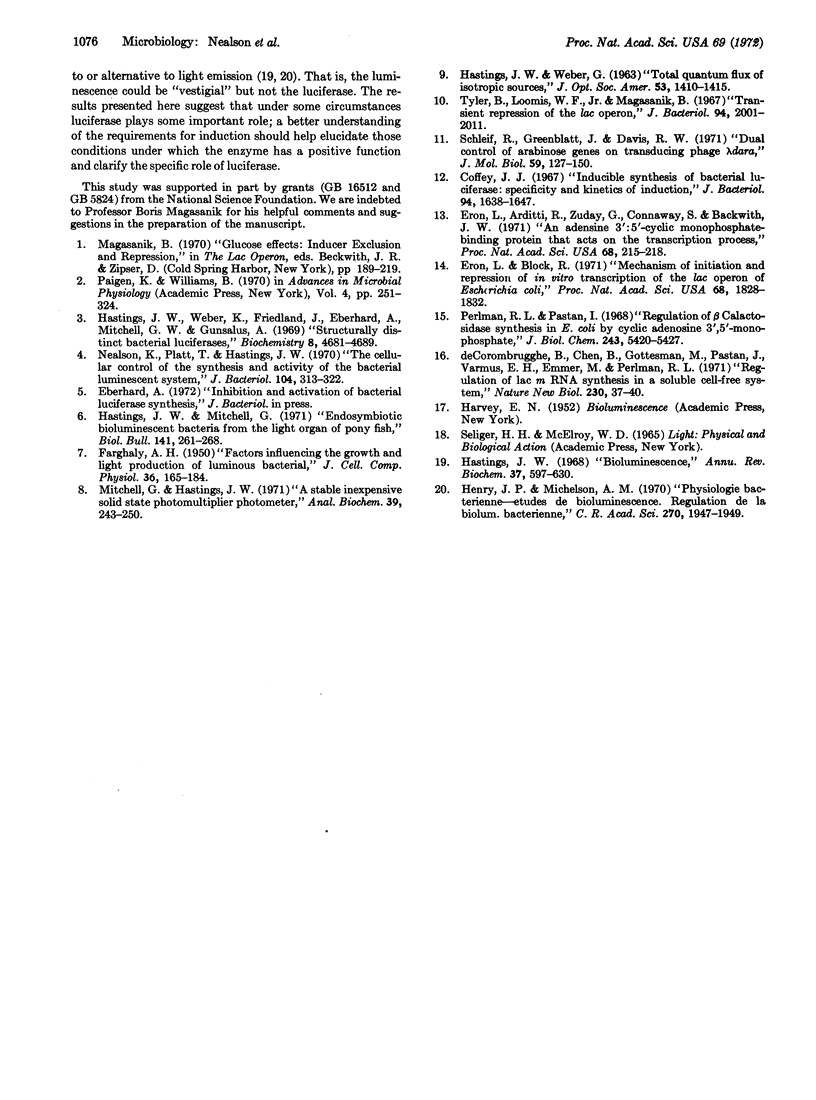Abstract
The synthesis of the bioluminescent system of the marine luminous bacterium Photobacterium fischeri (strain MAV) is subject to both transient and catabolite repression by glucose, and this repression can be reversed by adenosine 3′:5′-cyclic monophosphate. Catabolite repression is a mechanism that characteristically controls the synthesis of inducible enzymes involved in energy metabolism. The fact that luciferase synthesis is subject to this control suggests that whatever its role(s) may be, it cannot be considered a nonfunctional or vestigial enzyme system as previously hypothesized, and may actually have some more direct role in metabolic processes.
Keywords: cyclic AMP, inducible enzyme, luciferase, arginine, glucose
Full text
PDF



Selected References
These references are in PubMed. This may not be the complete list of references from this article.
- Coffey J. J. Inducible synthesis of bacterial luciferase: specificity and kinetics of induction. J Bacteriol. 1967 Nov;94(5):1638–1647. doi: 10.1128/jb.94.5.1638-1647.1967. [DOI] [PMC free article] [PubMed] [Google Scholar]
- De Crombrugghe B., Chen B., Gottesman M., Pastan I., Varmus H. E., Emmer M., Perlman R. L. Regulation of lac mRNA synthesis in a soluble cell-free system. Nat New Biol. 1971 Mar 10;230(10):37–40. doi: 10.1038/newbio230037a0. [DOI] [PubMed] [Google Scholar]
- Eron L., Arditti R., Zubay G., Connaway S., Beckwith J. R. An adenosine 3':5'-cyclic monophosphate-binding protein that acts on the transcription process. Proc Natl Acad Sci U S A. 1971 Jan;68(1):215–218. doi: 10.1073/pnas.68.1.215. [DOI] [PMC free article] [PubMed] [Google Scholar]
- Eron L., Block R. Mechanism of initiation and repression of in vitro transcription of the lac operon of Escherichia coli. Proc Natl Acad Sci U S A. 1971 Aug;68(8):1828–1832. doi: 10.1073/pnas.68.8.1828. [DOI] [PMC free article] [PubMed] [Google Scholar]
- FARGHALY A. H. Factors influencing the growth and light production of luminous bacteria. J Cell Physiol. 1950 Oct;36(2):165–183. doi: 10.1002/jcp.1030360205. [DOI] [PubMed] [Google Scholar]
- Hastings J. W., Weber K., Friedland J., Eberhard A., Mitchell G. W., Gunsalus A. Structurally distinct bacterial luciferases. Biochemistry. 1969 Dec;8(12):4681–4689. doi: 10.1021/bi00840a004. [DOI] [PubMed] [Google Scholar]
- Henry J. P., Michelson A. M. Etudes de bioluminescence. Régulation de la bioluminescence bactérienne. C R Acad Sci Hebd Seances Acad Sci D. 1970 Apr 13;270(15):1947–1949. [PubMed] [Google Scholar]
- Mitchell G. W., Hastings J. W. A stable, inexpensive, solid-state photomultiplier photometer. Anal Biochem. 1971 Jan;39(1):243–250. doi: 10.1016/0003-2697(71)90481-7. [DOI] [PubMed] [Google Scholar]
- Nealson K. H., Platt T., Hastings J. W. Cellular control of the synthesis and activity of the bacterial luminescent system. J Bacteriol. 1970 Oct;104(1):313–322. doi: 10.1128/jb.104.1.313-322.1970. [DOI] [PMC free article] [PubMed] [Google Scholar]
- Perlman R. L., Pastan I. Regulation of beta-galactosidase synthesis in Escherichia coli by cyclic adenosine 3',5'-monophosphate. J Biol Chem. 1968 Oct 25;243(20):5420–5427. [PubMed] [Google Scholar]
- Schleif R., Greenblatt J., Davis R. W. Dual control of arabinose genes on transducing phage lambda-dara. J Mol Biol. 1971 Jul 14;59(1):127–150. doi: 10.1016/0022-2836(71)90417-7. [DOI] [PubMed] [Google Scholar]
- Tyler B., Loomis W. F., Jr, Magasanik B. Transient repression of the lac operon. J Bacteriol. 1967 Dec;94(6):2001–2011. doi: 10.1128/jb.94.6.2001-2011.1967. [DOI] [PMC free article] [PubMed] [Google Scholar]


